| Horizontal Navigation Bar Page |
|---|
| QualityNet Lucid Suite is a toolset that enables users to plan and visualize collectively and virtually. Lucidspark and Lucidchart are available to CMS, CMS contractors and CMS stakeholders. - Facilitate effective meetings, planning sessions, and workshops with the right balance of structure and flexibility.
- Ideate in real time with teammates.
- Provide feedback, organize and vote on your team’s ideas, and create action items.
- Lucidspark isa virtual whiteboarding tool. With Lucidspark’s intuitive canvas, your team can collect and organize ideas — and then turn them into action. Lucidspark makes it easy to create a canvas from scratch or from a template, customize it to your liking, collaborate with your team, and put your ideas to work.
- Lucidchart is a web-based collaborative diagramming application that allows you to create and share technical diagrams. It also allows you to import environment information directly from sources such as AWS and automatically generate diagrams from that data.
| alert
|
| Panel |
|---|
| borderColor | black |
|---|
| borderStyle | solid |
|---|
| title | Have you registered for Lucid training? | type | Info |
|---|
|
Getting Started with LucidsparkThursday, May 11, 2023 at 9 a.m. Join the Lucid product pros to learn how to use Lucidspark. The basics of utilizing the basic tools for collaboration as well as best practices for creating an actionable brainstorming session that stimulates creativity and action will be covered. | Intro to Agile VisualizationTuesday, May 16, 2023 at 12 p.m. Creative processes need creative planning. Lucidspark provides the structure and visual collaboration in the spirit of agile planning. The pros will help align teams during standups, sprint planning, and retrospectives so teams can transform their ideas into action. | Designing Effective Meetings & Workshops in Lucidspark (Aimed for Scrum Masters and similar roles)Tuesday, May 23, 2023 at 9 a.m. Running workshops and meetings in the hybrid workspace comes with numerous challenges-participant engagement and connectedness, organizing activities, and more. Learn the best practices for designing and facilitating the perfect remote or hybrid working session with Lucidspark. |
|---|
Please see | Anchor |
|---|
| register2 | register2 | see the Getting Started tab to request your Lucid role before training.
| Horizontal Navigation Bar Page |
|---|
| Getting Started | Anchor |
|---|
| register | register
| Tabs Container |
|---|
|
| Tabs Page |
|---|
| Please see the chart below to help determine the best Lucid user option for you.  |
| Tabs Page |
|---|
| Licensed Users: Customers who can create and manage Lucidspark boards and Lucidchart diagrams.| Background Color |
|---|
| Licenses are intended for Board Owners, Scrum Masters, RTEs, Product Owners, and Team Managers. If this is not your role, please select an option below. If determined in the future a license is required, a HARP request should be submitted to move your user type. |
Requesting Your QualityNet Lucid Role in HARPRequires a HARP account (For instructions on the process, refer to the HARP page). Expand the steps below to view the role request process.
| Expand |
|---|
| title | Step 1: Go to https://harp.qualitynet.org/ and log in to your HARP account which will take you to your User Profile. From there, select “User Roles” |
|---|
| Go to https://harp.qualitynet.org and log into your HARP account. 
|
| Expand |
|---|
| title | Step 2: Request a role |
|---|
| 
|
| Expand |
|---|
| title | Step 3: Select the QualityNet Lucid Program. |
|---|
| 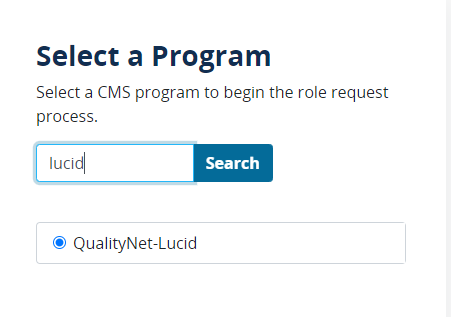
|
| Expand |
|---|
| title | Step 4: Select your Organization. |
|---|
| 
|
| Expand |
|---|
| title | Step 5: Select the required Lucid role. |
|---|
| 
|
| Expand |
|---|
| title | Step 6: You will be notified via email when your role has been approved. |
|---|
| Once your role has been approved by your SO, you will then have access to Lucid. |
|
| Tabs Page |
|---|
| Limited Access User (View Only Access): Customers become a registered user with Lucid. Each user can view Lucidspark boards shared with them.| Background Color |
|---|
| Lucidspark users can access a max of five (5) boards per year as a Limited Access User (via a shareable link with guest collaborator permissions from the host/owner). |
Requesting Your QualityNet Lucid Role in HARPRequires a HARP account (For instructions on the process, refer to the HARP page). Expand the steps below to view the role request process. | Expand |
|---|
| title | Step 1: Go to https://harp.qualitynet.org/ and log in to your HARP account which will take you to your User Profile. From there, select “User Roles” |
|---|
| Go to https://harp.qualitynet.org and log into your HARP account. 
|
| Expand |
|---|
| title | Step 2: Request a role |
|---|
| 
|
| Expand |
|---|
| title | Step 3: Select the QualityNet Lucid Program. |
|---|
| 
|
| Expand |
|---|
| title | Step 4: Select your Organization. |
|---|
| 
|
| Expand |
|---|
| title | Step 5: Select the required Lucid role. |
|---|
| 
|
| Expand |
|---|
| title | Step 6: You will be notified via email when your role has been approved. |
|---|
| Once your role has been approved by your SO, you will then have access to Lucid. |
|
| Tabs Page |
|---|
| Anonymous Guest: Users that are not registered with Lucid can join the board to collaborate and contribute to the work with a guest provided link from the host. | Background Color |
|---|
| This option does not require a Lucid role. Please reach out to the board owner to gain access as an Anonymous Guest. |
|
|
| Horizontal Navigation Bar Page |
|---|
| Integrations
Lucidspark with Jira Customers can accomplish moving from brainstorming and ideation to big room planning, roadmapping, sprint planning, basic dependency mapping, and backlog refinement. The Lucid Cards for Jira integration allows customers to easily import Jira issues into Lucidspark and refresh your Cards to reflect any changes made in Jira. Cards are bidirectionally synced with Jira in real-time. Edits made in Lucidspark are pushed back to Jira and edits in Jira are pulled into Lucidspark.
| Tabs Container |
|---|
|
| Tabs Page |
|---|
| title | Authentication Jira within Lucidspark |
|---|
| You will need to authenticate into Jira the first time you use it in a board, which you can do by following these steps: - Open a Lucidspark board.
- Click
 the Jira icon on the left. the Jira icon on the left. - You will be asked to authenticate into Atlassian (Jira). Please sign in and authorize Lucid to access your Atlassian account.
|
| Tabs Page |
|---|
| title | Importing existing Jira issues |
|---|
| 1.Open your Lucidspark board. 2. Click the Jira icon  on the left and select Import Jira issues. on the left and select Import Jira issues. 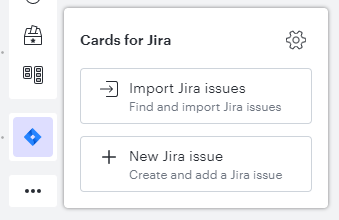
3. Choose which issues to import. 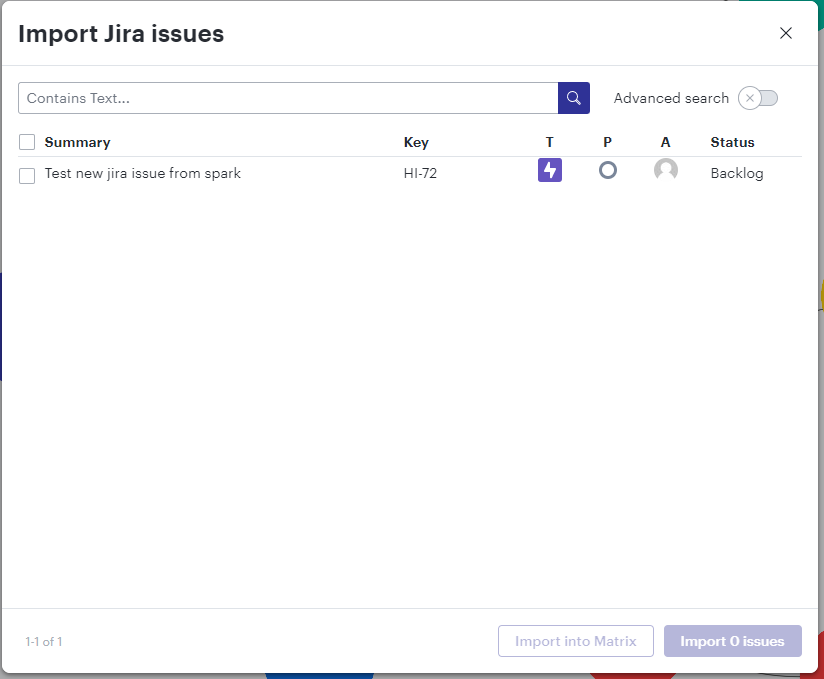 4. Once the issue is imported into your Lucidspark board, you can edit the Issue Summary on the card itself and edit other fields In the context menu. Editing the other fields requires ensuring the card is selecting and clicking on the pencil icon. |
| Tabs Page |
|---|
| title | Create New Jira issues |
|---|
| 1.Open your Lucidspark board. 2. Click the Jira icon  on the left and select New Jira issue. on the left and select New Jira issue. 
3. Enter required fields for the project or issue type. 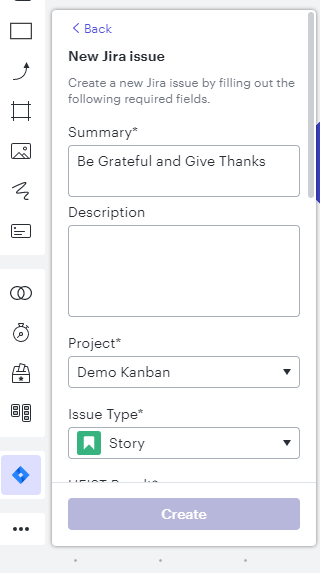
4. Click Create. |
| Tabs Page |
|---|
| title | Dynamic Matrix for Jira |
|---|
| Follow the steps below to successfully import your Jira issues into the Dynamic Matrix, pivot the matrix, and update data. Import Jira issues into the Dynamic Matrix - Open a Lucidspark board.
- Click the Jira icon and select Import Jira issues.
- Select the issues you want to import.
- Select Import into Matrix.
Pivoting the Dynamic Matrix Click the Dynamic Matrix and use the field drop down menus to pivot the configuration of the matrix. 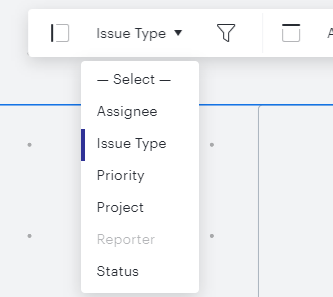
You can also click and drag rows and columns to rearrange them.
Filter Rows and Columns Using the filter icon, you can filter which values appear in the matrix for each pivot. 
Edit Cards in a Dynamic Matrix You can double click on Cards to edit their data as you would outside the Dynamic Matrix. 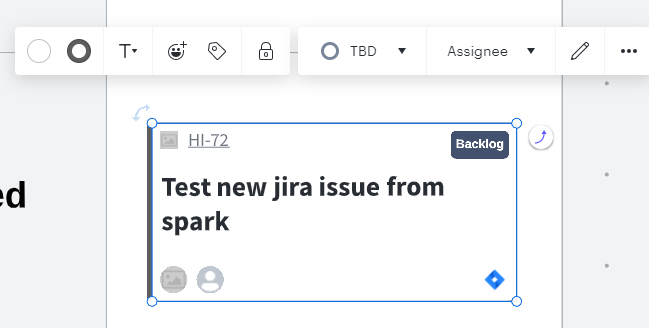
You can also edit Jira fields by dragging cards across rows and columns. |
| Tabs Page |
|---|
| title | Converting sticky notes to Jira |
|---|
| - Right click on either an individual sticky note or a group of sticky notes and select Convert to Jira issue.
  - Fill out the required fields.
  - You can edit more information after you convert your sticky note(s).
|
|
|
| Horizontal Navigation Bar Page |
|---|
| Resources
|
| Horizontal Navigation Bar Page |
|---|
| How To's
| Expand |
|---|
| title | Lucidspark for Facilitators |
|---|
| | Multimedia |
|---|
| name | Lucidspark for Facilitators.mp4 |
|---|
| width | 100% |
|---|
| height | 100% |
|---|
|
Lucidspark for Facilitators.mp4 |
|
| Horizontal Navigation Bar Page |
|---|
| FAQs
| Panel |
|---|
| borderColor | #254b78 |
|---|
| titleColor | #ffffff |
|---|
| borderWidth | 1 |
|---|
| titleBGColor | #254b78 |
|---|
| borderStyle | solid |
|---|
| title | General |
|---|
|
| Expand |
|---|
| Lucidspark is a virtual whiteboard where teams connect and convey their greatest ideas to light. The goal is to allow teams to brainstorm and share their ideas through teamwork and better organization. |
| Expand |
|---|
| Lucidchart is a virtual diagramming application where teams work together to make and build better decisions. Whatever your objective, Lucidchart allows you to envision ideas more clearly, faster, and through teamwork. |
|
| Panel |
|---|
| borderColor | #254b78 |
|---|
| titleColor | #ffffff |
|---|
| borderWidth | 1 |
|---|
| titleBGColor | #254b78 |
|---|
| borderStyle | solid |
|---|
| title | Working in Lucidspark |
|---|
|
| Expand |
|---|
| title | Can I link one part of the board to another? |
|---|
| Not at this time, Lucid is looking into this as a future enhancement. |
| Expand |
|---|
| title | How to create breakout boards? |
|---|
| To create a new Breakout Board: - Select
 the Breakout Board icon from the Primary Toolbar. the Breakout Board icon from the Primary Toolbar. - Click the tile to “Add new breakout”.
A Breakout Board will be automatically labeled. To rename a board, join the board you’d like to update and type the new title in the upper left-hand corner. |
| Expand |
|---|
| title | How to manage board participants? |
|---|
| To start the breakout session, select Start Breakout. The Breakout Boards panel will become visible to all participants and they'll be able to select a board to join, which will send them to a separate Lucidspark board. 
You can also share a direct link to a Breakout Board. You can do this by selecting Copy direct link from the three-dot menu in the Breakout Board panel and from within a Breakout Board by selecting  in the upper-right corner. in the upper-right corner. Note: Shareable Links will need to be enabled from the Main Board's Share settings to allow creation of and access to direct links. 
When the session is over, select Call Back to bring everyone back to the Main Board. Participants can also navigate back to the main board themselves at any time by clicking  in the upper-left side corner. in the upper-left side corner. 
|
| Expand |
|---|
| title | How do I track the changes collaborators made? |
|---|
| Lucidspark keeps a log of all changes made to a board using the Revision History tool! It's accessible within the menu near the title of your board. 
The board’s edit history will display as a list of stacked tiles, with each tile representing a past version of the board. Each tile will display the date and time the changes were made, as well as the full name or email address of the user who made the changes.
|
| Expand |
|---|
| title | How do I manage breakout boards? |
|---|
| Add a Note to a Shape To add a note to a shape, right click on the shape and select “Add Note” from the dropdown. Note Icon on Shape After adding a note to a shape, you will see  the note icon on the top right corner of the shape. If you click on the note icon, it will show the note you added. the note icon on the top right corner of the shape. If you click on the note icon, it will show the note you added. Delete a Note from a Shape To delete a note from a shape, right click on the shape and select “Delete Note” from the dropdown. |
| Expand |
|---|
| title | Where can images be attached? |
|---|
| You have multiple options when managing Breakout Boards. To access this menu, hover over a board’s tile and select the three-dot menu. 
With this menu you can: - Join a board to participate
- Rename a board to customize its title
- Copy direct link to share with participants
- Duplicate a board
- Insert all content of a Breakout Board to the Main Board
- Delete a board
A few tips - Anyone on your Enterprise account with edit permissions to a board can create Breakout Boards.
- View-only users can join and view Breakout Boards.
- Guest Collaborators and free users can participate in existing Breakout Boards.
- Participants will only see collaborators for the Breakout Board they are in.
- You can move over specific shapes from the Breakout Board to the main board.
- To add a single shape, copy the shape and paste it in the Main Board.
- To select multiple shapes, hold the Shift key while selecting shapes to copy, then paste in the Main Board.
- You can also add all content of a Breakout Board to the Main Board by dragging and dropping the thumbnail of a board from the Breakout Board panel onto the canvas.
|
| Expand |
|---|
| title | How do I add web link in Lucidspark? |
|---|
| To add a web link to an object: - Select a shape.
- Click the link icon from the Context Toolbar.
- Paste the URL and click Apply.
- To change the shape to display a preview of the linked content, select Convert to Link Preview.

Link PreviewIf you convert to Link Preview, a separate shape containing a thumbnail will be populated. You may see the following options in the Context Toolbar for the thumbnail:  Refresh the thumbnail image(s) Refresh the thumbnail image(s)  Navigate thumbnails will appear as arrows that will allow you to switch between the images, if there are more than one Navigate thumbnails will appear as arrows that will allow you to switch between the images, if there are more than one Extract thumbnails to extract the thumbnail image(s) Extract thumbnails to extract the thumbnail image(s) Expand view if there is an iframe to display Expand view if there is an iframe to display
Add a Web Link to textTo add a web link to specific text (whether in a text box or on an object), highlight the portion of the text that you would like linked and then follow the steps explained above — select the link icon from the Context Toolbar, paste in the URL, and hit “Apply.” A blue line will appear under the selected text to indicate that a web link has been applied. 
Trigger the LinkTo trigger the link and open the linked webpage on a PC, press Shift + Ctrl and then click on the object or text that you applied a web link to. If you are using a Mac, press Shift + Command and then click on the object or text. These instructions will also appear on your board if you hover over/click on an object that has a web link attached to it. 
|
| Expand |
|---|
| title | How do I modify or customize lines in Lucidspark? |
|---|
| All formatting tools for lines are available in the Formatting Toolbar when a line is selected.
|
|
| Panel |
|---|
| borderColor | #254b78 |
|---|
| titleColor | #ffffff |
|---|
| borderWidth | 1 |
|---|
| titleBGColor | #254b78 |
|---|
| borderStyle | solid |
|---|
| title | Working in Lucidchart |
|---|
|
| Expand |
|---|
| title | How do I import Excel spreadsheets? |
|---|
| To import a data set from Google Sheet, Excel, or CSV into a Lucidchart document, follow these steps: - Open a Lucidchart document.
- Click
 the data linking icon in the left bar. the data linking icon in the left bar. - Click Link Data.
- In the window that appears, click Import Your Data.
- Select the file type (Google Sheets, Excel, or CSV) that you would like to import, or select to choose a file that you have already uploaded to Lucidchart.
- Click Choose File.
- If you are importing data from a Google Sheet, you will need to grant Lucidchart permission to access your Google account. Click Authenticate, select your Google account, and click Allow to grant this permission.
- Select an Excel or CSV file from your device and click Open.
- If you are importing data from a Google Sheet, select a sheet and click Select.
- Select which pages of your spreadsheet you want to import and click Next.
- After importing your data, Lucidchart will prompt you to identify the header row of your data set. Select your header row.
- Click Next.
- In the next window, Lucidchart will prompt you to select a column of your data that contains reference keys for the contents of each row. Reference keys allow Lucidchart to keep track of your data even after you make structural changes to it, such as removing, adding, or reordering rows. Select the column that contains unique identifiers, if you have one.
- Click Finish.
|
| Expand |
|---|
| title | How can I attach an image in Lucidchart? |
|---|
| Select Where to Attach Image on Editor Select the Shape, Line, Page, etc. that you wish to attach an image to. Your image with be attached to whatever you have selected, be it a page or a shape. Locate the Attach Images feature The Attached Images feature can be found in the menu on the right hand side of the editor. Click on  the menu icon to open up the options and upload Attached Images. the menu icon to open up the options and upload Attached Images. Upload images into the Attach Images section You can attach images via the (+) icon, by clicking ‘Choose a file’, or by dragging & dropping a file into the Attach Images section. 
Supported file types are: .bmp, .gif, .jpeg, .jpg, .png, .jpe, .tiff, .tif, .psd, .ai, .pdf, and .svg Note: Since PDFs will be attached as an image, only the first page of the PDF will be attached. Attach Image Icon on Shapes If you attach an image to a shape, you will see  the image icon on the right upper corner of the shape. the image icon on the right upper corner of the shape. |
| Expand |
|---|
| title | How can I add more shape libraries to my document? |
|---|
| You can add shape libraries to your document by selecting the boxes next to shape libraries in the Shapes section of the Workspace Manager. Click the triangle next to a library's name to expand a list of its sub-libraries. |
| Expand |
|---|
| title | How can I move around the canvas? |
|---|
| Right-click and drag the canvas to adjust your view. When you hold down the right-click, your cursor becomes a hand grabbing the canvas as you move the document to see other content. |
| Expand |
|---|
| title | How can I access Revision History? |
|---|
| To access Revision History, select  the clock icon from the menu bar at the top of your document. Alternatively, select Revision History from the File menu. the clock icon from the menu bar at the top of your document. Alternatively, select Revision History from the File menu. The document’s edit history will display as a list of stacked tiles, with each tile representing a past version of the document. Each tile will display the date and time the changes were made, as well as the full name of the user who made the changes. 
Note: The times will correspond with the time zone of the current document viewer. 
Scroll to the bottom of the menu to see how long ago the document was created. 
|
| Expand |
|---|
| title | What kind of sharing permissions does Lucidchart provide? |
|---|
| There are four tiers of sharing permissions that you can choose from when sharing folders, documents, boards, and models: - Can edit and share
- Can edit
- Can comment
- Can view
You can set different permissions for each collaborator and adjust them any time. To adjust permissions, follow these steps: - Navigate to Share, as described in the sections above.
- Select Manage in the Collaborators section.
- Click the sharing permissions icon for the user you would like to adjust the sharing permissions for.
- Select the desired permission option from the dropdown.

Note: If a collaborator is on a lower-level account type than you, they may not be able to edit the shared document, boards, and models even if you have given them edit access. |
| Expand |
|---|
| title | How do I transfer document ownership? |
|---|
| You can transfer ownership of documents and boards from both the Documents page and from within the editor. To transfer ownership, follow these steps: - Navigate to Share from your Documents page or from within the editor of the document you wish to transfer ownership of, as described in the sections above.
- Select Manage in the Collaborators section.
- Click the sharing permissions icon for the person you would like to transfer ownership to.
- Select Make owner.
- In the confirmation window that appears, select whether or not you would like to remain as a collaborator.
- Click Make owner.
The new owner will receive a notification that they are now the owner of the document or board. |
| Expand |
|---|
| title | How can I unshare a shared document, board, or model? |
|---|
| To unshare, open the document, board, or model. Then, click Share again, select Manage in the Collaborators section, and then click “X” to remove the collaborator. You can also adjust your collaborator’s editing permissions here. |
| Expand |
|---|
| title | If I delete a swim lane from my diagram, will its contents also be erased? |
|---|
| No. When you delete a swim lane, its contents will remain on the canvas. To do this, right-click the swim lane header and select Delete (or select the swim lane and press Delete on your keyboard). If you want to erase both the swim lane and its contents, click Remove Lane in the right-click menu. |
|
| Panel |
|---|
| borderColor | #254b78 |
|---|
| titleColor | #ffffff |
|---|
| borderWidth | 1 |
|---|
| titleBGColor | #254b78 |
|---|
| borderStyle | solid |
|---|
| title | Working with Lucid Cards in Jira |
|---|
|
| Expand |
|---|
| title | What templates are available for Cards? |
|---|
| Currently templates for big room planning, user story mapping, backlog prioritization, retrospectives, roadmapping, and more. You can also copy and paste any template from Lucidchart directly into Lucidspark. |
| Expand |
|---|
| title | Where are my custom fields? |
|---|
| You can access your custom fields from Jira on your Lucidspark cards and choose which custom fields are brought in. You will have view-only access to your custom fields. |
| Expand |
|---|
| title | Can I copy Lucid Cards between documents? |
|---|
| Yes the card will copy, but the data will not copy. It’s better to re-import the Cards on a new document. |
| Expand |
|---|
| title | Can I import Jira data from multiple Jira instances onto the same board? |
|---|
| No, Lucidspark only supports data from one Jira instance per document. |
|
|
|

 ISG Playbook
ISG Playbook One SOG Game Plan
One SOG Game Plan Enterprise Services
Enterprise Services EQRS
EQRS HQR
HQR iQIES
iQIES QIES
QIES QIO
QIO SOG
SOG CCSQ QNet Library
CCSQ QNet Library APIs
APIs Communications
Communications Data & Analytics
Data & Analytics DevOps & Cloud
DevOps & Cloud Human-Centered Design
Human-Centered Design IT Governance
IT Governance Lean-Agile Center of Excellence
Lean-Agile Center of Excellence Portfolio Management
Portfolio Management QNet Chat
QNet Chat QualityNet IT Services
QualityNet IT Services Resilience
Resilience  Risk Management
Risk Management Security
Security ServiceNow
ServiceNow Knowledge Base
Knowledge Base Contact Atlassian Support
Contact Atlassian Support DAB
DAB DHAQS
DHAQS DPES
DPES DQSAS
DQSAS DQSGED
DQSGED DQSOS
DQSOS ISS
ISS SIS
SIS CCOM
CCOM HEIST
HEIST PM3
PM3